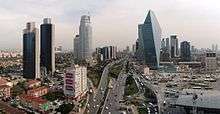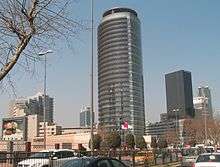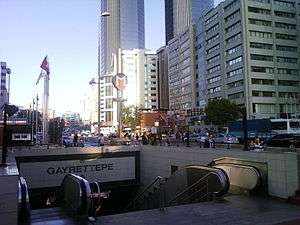Levent

Levent is a neighbourhood and one of the main business districts of Istanbul, Turkey, located on the European side of the city. It is a part of the municipality of Beşiktaş which is situated to the north of the Golden Horn, at the western shore of the Bosphorus strait.
Levent is in direct competition with the nearby Maslak business district for new skyscraper projects. One of the major skyscraper clusters of the city is located here, well hidden behind the hills of the Bosphorus, and not disturbing the atmosphere of the historical peninsula of Istanbul, which is at quite a distance.
Levent[1] hosts the tallest completed skyscraper of Turkey, the 54-floor Sapphire,[2] which has a roof height of 238 metres (261 metres including its spire).[2]
The stations Gayrettepe, Levent and 4. Levent along the M2 line of the Istanbul Metro serve the Levent business district and its surrounding neighbourhoods.
Etymology

Levent is also a name for men in Turkey; see Levent (name). The name derives from Levend (Marine Soldier) of the Ottoman Navy.[3] Levend itself has derived from Levantino (Levantine) which means Person from the Levant (East Mediterranean) in Italian.[3][4] This was how the Italians (the Genoese and Venetians) used to call the Ottoman sailors, a name which was also adopted by the Ottoman Turks.[3][4][5] The use of the word levend for describing seamen first appeared in the Ottoman Turkish language during the 16th century.[5] These marine soldiers had the reputation of possessing strong, muscular physiques and daring, fearless characters; which is the reason why the Turkish word levent, its Greek cognate levénti (λεβέντη) and its Bulgarian cognate levént (левент) are still popularly used for defining "athletic, gallant, brave" men.[4]
The name Levent (Levend) came to be applied to the neighbourhood because in 1780 the Ottoman Fleet Admiral Cezayirli Gazi Hasan Pasha was awarded a farmland here by the Ottoman Sultan Abdülhamid I; and in the early 19th century a military compound was built in the area of this farm.[6] The nearby İstinye neighbourhood on the European shoreline of the Bosphorus also featured an important shipyard and dock for maintaining and repairing the military vessels of the Ottoman Navy. However, the Imperial Arsenal (Tersâne-i Âmire) and the Naval Ministry (Bahriye Nezareti) of the Ottoman Navy were located on the shores of the Golden Horn.
History

.jpg)
In the early 19th century, during the final years of the reign of Sultan Selim III, the first military compound of the Nizam-ı Cedid (New Order) Army was built in Levent; which was then known as the Levend Çiftliği (Levend Farmlands), eventually becoming known as the Levend Kışlası (Levend Barracks).
In 1868, during the first territorial organization of the Istanbul Municipality, Levend (Levent) was placed within the district of Beşiktaş (which was designated as the 7th Area of the Istanbul Municipality), having remained within this district ever since.
The modern neighbourhood of Levent was formed in 1947, when Emlak Kredi Bankası (a Turkish bank which was established to finance housing projects) chose the Levent area for constructing a well-planned residential compound, formed mostly of villa type houses with gardens. After the completion of the first phase of the Levent project in 1960, numerous other residential compounds were constructed in the area, eventually extending towards nearby Etiler.
Starting from the late 1980s and early 1990s, with initial projects such as the Sabancı Center, Yapı Kredi Towers, TAT Towers, Metrocity Towers and İş Bankası Towers, Levent became a popular location for constructing new skyscrapers, mostly owned by Turkish banks and conglomerates. One of the city's major skyline clusters (together with those of Maslak and Şişli on the European side; and Ataşehir and Kozyatağı on the Asian side of Istanbul) is located in Levent. At present, Levent hosts the tallest skyscraper of Istanbul and Turkey, the 54-floor Istanbul Sapphire; while the construction of numerous new mixed-use skyscraper projects and shopping malls are ongoing in the neighbourhood, which has evolved into a central business district.
Image gallery
 Istanbul Sapphire is currently the tallest skyscraper in Levent
Istanbul Sapphire is currently the tallest skyscraper in Levent View of the Türkiye İş Bankası headquarters from Istanbul Sapphire
View of the Türkiye İş Bankası headquarters from Istanbul Sapphire- View of the Finansbank headquarters from the observation deck of Istanbul Sapphire
.jpg) View of the Bosphorus Bridge, the Anatolian side of Istanbul, and the Prince Islands in the Sea of Marmara from Levent
View of the Bosphorus Bridge, the Anatolian side of Istanbul, and the Prince Islands in the Sea of Marmara from Levent Özdilek Center Wyndham Grand Hotel
Özdilek Center Wyndham Grand Hotel- Levent station of the Istanbul Metro
.jpg)

 Özdilek Park on Büyükdere Avenue
Özdilek Park on Büyükdere Avenue Gayrettepe station of the Istanbul Metro
Gayrettepe station of the Istanbul Metro
See also
- Maslak
- Bankalar Caddesi
- List of tallest buildings in Istanbul
- List of tallest buildings in Turkey
- Architecture of Turkey
References and notes
- ↑ Emporis: Levent
- 1 2 Emporis: Sapphire
- 1 2 3 Kıyafet-i Asakir-i Bahriyye: Costumes and ranks of the Ottoman Navy
- 1 2 3 Dictionary of American Family Names, Oxford University Press, ISBN 0-19-508137-4.
- 1 2 Sevan Nişanyan. Sözlerin Soyağacı: Çağdaş Türkçenin Etimolojik Sözlüğü. URL: http://www.nisanyansozluk.com/search.asp?w=levent Retrieved 30 October 2009.
- ↑ Haldun Hürel. Semtleri, Mahalleri, Caddeleri ve Sokakları A'dan Z'ye İstanbul'un Alfabetik Öyküsü. İkarus, 2008. ISBN 978-975-999-290-3. Page 220.
External links
| Wikimedia Commons has media related to Levent. |
Coordinates: 41°04′55″N 29°00′57″E / 41.08181°N 29.01584°E